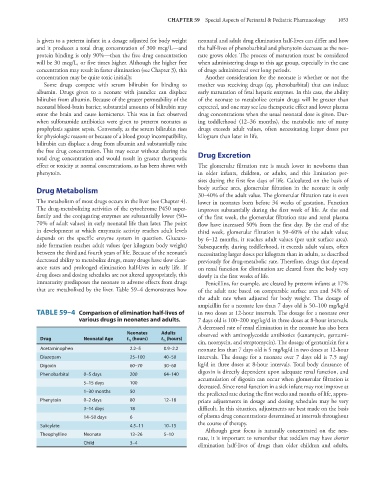Page 1067 - Basic _ Clinical Pharmacology ( PDFDrive )
P. 1067
CHAPTER 59 Special Aspects of Perinatal & Pediatric Pharmacology 1053
is given to a preterm infant in a dosage adjusted for body weight neonatal and adult drug elimination half-lives can differ and how
and it produces a total drug concentration of 300 mcg/L—and the half-lives of phenobarbital and phenytoin decrease as the neo-
protein binding is only 90%—then the free drug concentration nate grows older. The process of maturation must be considered
will be 30 mcg/L, or five times higher. Although the higher free when administering drugs to this age group, especially in the case
concentration may result in faster elimination (see Chapter 3), this of drugs administered over long periods.
concentration may be quite toxic initially. Another consideration for the neonate is whether or not the
Some drugs compete with serum bilirubin for binding to mother was receiving drugs (eg, phenobarbital) that can induce
albumin. Drugs given to a neonate with jaundice can displace early maturation of fetal hepatic enzymes. In this case, the ability
bilirubin from albumin. Because of the greater permeability of the of the neonate to metabolize certain drugs will be greater than
neonatal blood-brain barrier, substantial amounts of bilirubin may expected, and one may see less therapeutic effect and lower plasma
enter the brain and cause kernicterus. This was in fact observed drug concentrations when the usual neonatal dose is given. Dur-
when sulfonamide antibiotics were given to preterm neonates as ing toddlerhood (12–36 months), the metabolic rate of many
prophylaxis against sepsis. Conversely, as the serum bilirubin rises drugs exceeds adult values, often necessitating larger doses per
for physiologic reasons or because of a blood group incompatibility, kilogram than later in life.
bilirubin can displace a drug from albumin and substantially raise
the free drug concentration. This may occur without altering the
total drug concentration and would result in greater therapeutic Drug Excretion
effect or toxicity at normal concentrations, as has been shown with The glomerular filtration rate is much lower in newborns than
phenytoin. in older infants, children, or adults, and this limitation per-
sists during the first few days of life. Calculated on the basis of
Drug Metabolism body surface area, glomerular filtration in the neonate is only
30–40% of the adult value. The glomerular filtration rate is even
The metabolism of most drugs occurs in the liver (see Chapter 4). lower in neonates born before 34 weeks of gestation. Function
The drug-metabolizing activities of the cytochrome P450 super- improves substantially during the first week of life. At the end
family and the conjugating enzymes are substantially lower (50– of the first week, the glomerular filtration rate and renal plasma
70% of adult values) in early neonatal life than later. The point flow have increased 50% from the first day. By the end of the
in development at which enzymatic activity reaches adult levels third week, glomerular filtration is 50–60% of the adult value;
depends on the specific enzyme system in question. Glucuro- by 6–12 months, it reaches adult values (per unit surface area).
nide formation reaches adult values (per kilogram body weight) Subsequently, during toddlerhood, it exceeds adult values, often
between the third and fourth years of life. Because of the neonate’s necessitating larger doses per kilogram than in adults, as described
decreased ability to metabolize drugs, many drugs have slow clear- previously for drug-metabolic rate. Therefore, drugs that depend
ance rates and prolonged elimination half-lives in early life. If on renal function for elimination are cleared from the body very
drug doses and dosing schedules are not altered appropriately, this slowly in the first weeks of life.
immaturity predisposes the neonate to adverse effects from drugs Penicillins, for example, are cleared by preterm infants at 17%
that are metabolized by the liver. Table 59–4 demonstrates how of the adult rate based on comparable surface area and 34% of
the adult rate when adjusted for body weight. The dosage of
ampicillin for a neonate less than 7 days old is 50–100 mg/kg/d
TABLE 59–4 Comparison of elimination half-lives of in two doses at 12-hour intervals. The dosage for a neonate over
various drugs in neonates and adults. 7 days old is 100–200 mg/kg/d in three doses at 8-hour intervals.
A decreased rate of renal elimination in the neonate has also been
Neonates Adults observed with aminoglycoside antibiotics (kanamycin, gentami-
Drug Neonatal Age t ½ (hours) t ½ (hours)
cin, neomycin, and streptomycin). The dosage of gentamicin for a
Acetaminophen 2.2–5 0.9–2.2 neonate less than 7 days old is 5 mg/kg/d in two doses at 12-hour
Diazepam 25–100 40–50 intervals. The dosage for a neonate over 7 days old is 7.5 mg/
Digoxin 60–70 30–60 kg/d in three doses at 8-hour intervals. Total body clearance of
digoxin is directly dependent upon adequate renal function, and
Phenobarbital 0–5 days 200 64–140
accumulation of digoxin can occur when glomerular filtration is
5–15 days 100
decreased. Since renal function in a sick infant may not improve at
1–30 months 50 the predicted rate during the first weeks and months of life, appro-
Phenytoin 0–2 days 80 12–18 priate adjustments in dosage and dosing schedules may be very
3–14 days 18 difficult. In this situation, adjustments are best made on the basis
14–50 days 6 of plasma drug concentrations determined at intervals throughout
the course of therapy.
Salicylate 4.5–11 10–15
Although great focus is naturally concentrated on the neo-
Theophylline Neonate 13–26 5–10
nate, it is important to remember that toddlers may have shorter
Child 3–4 elimination half-lives of drugs than older children and adults,

